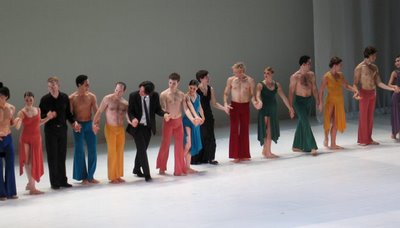The Washington Ballet is back on its feet, presenting two world premieres united under a title “Bach/Beatles Project” at the Kennedy Center’s Eisenhower Theater. “How wonderful to be back in the studio!” remarked Artistic Director of the Washington Ballet Septime Werbre before the curtain rose after the newly negotiated labor contract finally put an end to a lengthy period of cancellations, uncertainty, and unemployment for the company’s 20 dancers, returning them on stage.
Sarah Kaufman, Washington Ballet, 'Bach' and Feeling Fab (Washington Post, May 13) Jean Battey Lewis, Fully loaded Bach fuses with Beatles (Washington Times, May 13) Brian Moylan, Beatles & Bach put to ballet (Washington Blade, May 12) |
With dazzling speed the dancers appeared on stage, twisting and turning their bodies, rotating each other, and leaping in the air; men lifting, throwing, and catching men; men lifting, throwing, and catching women… They were gymnasts, acrobats, runners, figure skaters, martial artists, and ballroom dancers. At their best, their performance was electrifying and technically near flawless. Dancing in threesomes (Variation 6) demonstrated that the extra pair of helping hands makes lifting and spinning ladies in the air look remarkably effortless. A golden girl of the Washington Ballet, gorgeous Michele Jimenez, was very effective in duets with Luis Torres and Morgann Rose. Her polished movements, breathtaking extensions, and absolutely astonishing flexibility made her a centerpiece of the show. [According to The Washingtonian, Jimenez will leave Washington for the Dutch National Ballet in August. -- CTD] During the first ‘intermission’ two quartets of the dancers rolled a harpsichord on stage (with harpsichordist Scott Dettra) and a piano (with a pianist Ralitza Patcheva), in what appeared to be a waltz of these two instruments. After a little dance, the piano left the stage and gave place to the instrument Bach would have had at his disposal.

The second act brought a change in tempi and clothes: slower, dotted with colored skirts and dresses for the corps, which proved easier on the eye than their original mouse-colored underwear. The slower music transformed the nature of the choreography: dances became more sensual and amorous. One of the most memorable performances in the harpsichord part was a love-duet by Laura Urgelles and Jonathan Jordan in a traditional classical ballet movement set to Variation 21. Their performance had so much elegance and tenderness, one didn’t want this dance to end. The martial arts scene completed the second act and the piano returned on stage. Men changed skirts to colored pants and the women's dresses acquired more sophisticated design. As music became slower so did the pace of the dances: in the beginning of the third section it was almost like watching a movie played at a very slow speed. It all changed when Jason Hartley and Jonathan Jordan flew on stage, proving wrong anyone who says “White men can’t jump.” The Aria Da Capo fluently danced by Jason Hartley completed the Bach program. Webre’s Variations received a warm approval from the audience.
After intermission it was a Beatles hit-parade. Choreographed by very-much-in-demand Washington Ballet resident choreographer Trey McIntyre, this ballet was titled “Always, No Sometimes.” It was a concert and a dance performance all together, starring John Lennon and Jason Hartley. Dressed in all white by costume designer Liz Prince, the Washington Ballet showcased McIntyre’s innovative and compelling approach to modern dance. The Beatles couldn’t have asked for a better staged and executed backup dancing. If anyone had doubts about the future of the Washington Ballet, after this program, it’s obvious -- the company is back in business. Hopefully for Always, No(t) Sometimes.
The repeat performances are tonight at 8pm, Saturday at 2:30pm & 8pm and Sunday at 1pm & 5pm.
Hey, jfl, have you heard this??
ReplyDeletehttp://www.bbc.co.uk/radio4/science/mozarteffect.shtml
Gawain